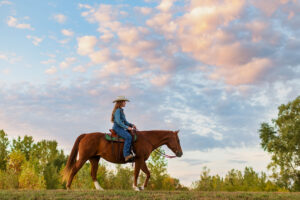Equine First-Aid Basics, Part 1
- Topics: Bandaging, Diseases and Conditions, Emergency Planning, Eye & Ear Problems, Farm and Barn, First Aid, First Aid & Emergency Care, Hoof Care, Horse Care, Lameness, Medications, Other Eye Problems, Safety, Sports Medicine, Tack, Equipment & Products, Trailers & Trailer Safety, Vital Signs & Physical Exam, Welfare and Industry, Working With a Veterinarian

Assemble the perfect first-aid kit for unexpected emergencies
Lacerations, punctures, colic, abscesses, eye injuries, choke. Equine emergencies happen every day (and night). And the next horse involved could be yours. Would you be ready to handle it? To make sure you’re as prepared as possible, we’ve worked with practicing veterinarians to develop some guidelines we’ll present in a two-part series.
In part one, we’ll look at the “tools of the trade”—the items that should be in your first-aid kit, what they’re used for, and how to store them. Next month we’ll address how to use these tools and what skills you need as a “first-responder” to your horse’s health issues.
Bandages and Padding
An all-too-common emergency is the open wound, especially on a leg. Stopping the blood flow in equine wounds is critical and is primarily done by applying pressure, says Matthew Randolph, DVM, of the Equine Veterinary Hospital of Northern Indiana, in Bremen.
Smart horse owners keep a good stock of 100% cotton bandages, such as sheet cotton, in their first-aid kits. “I like to cut 1-meter (3.28-foot) strips and roll them up in rubber bands to have easily on hand in an emergency,” says Benjamin Buchanan, DVM, Dipl. ACVIM, ACVECC, of Brazos Valley Equine Hospital, in Navasota, Texas.

Randolph says to keep some disposable self-adherent bandage (such as Vetrap) on hand, as well; this will maintain pressure over the wound. However, be sure to use padding beneath it.
“There’s not enough connective tissue (mainly skin) to protect the tendon and the skin if you use adhesive bandages alone,” Buchanan says. “They can cause more damage than good. I’ve even seen them function as a tourniquet and cause the foot to die,” a fatal injury for the horse.
Shipping quilts (aka pillow wraps) or ample sheet cotton can serve as padding beneath bandages. And our sources agree that quilts combined with polos or elastic track or stable bandages also work very well for leg wounds.
Disposable baby diapers also work well for leg wounds, adds Randolph. “They have nice padding and absorbability, and they can be adjusted to add just the right amount of pressure to get the bleeding to stop,” he says.
Wound- and Eye-Cleaning Products
Before you wrap that wound, be sure you guard against trapping dirt and germs with it. Your kit needs to include a good wound cleanser. A liquid or spray disinfectant such as Betadine can be useful, but apply it with care. Overcleaning can be detrimental, Randolph says.
“I’m a huge proponent of mild, unscented hand soap, which is perfect for wound-cleaning,” he says. “You need to avoid getting so aggressive with wound-cleaning that you slow down the (blood) clotting and make things worse. The most important thing is just to get the debris cleaned off and get the bleeding stopped until your vet can get there.”
For eye injuries, stock a small bottle of sterile saline solution. Your veterinarian might prescribe non-steroidal ophthalmic ointments such as Neomycin and Polymyxin B Sulfates after examining the case, Buchanan says. Check back next month for tips on handling equine eye injuries.
The Veterinarian’s First-Line Drugs
It used to be that veterinarians always recommended horse owners have certain prescription drugs at the ready, but this is no longer the case. Not only is it against many state veterinary practice acts, but improper administration can lead to dangerous complications and reactions, as well. Always rely on your veterinarian’s advice following an exam of your horse before administering any prescription drug.
Your veterinarian will administer these medications via different routes (into a vein, into a muscle, under the tongue, etc.); which one they choose depends on the advantages/disadvantages each offers
—Christa Lesté-Lasserre, MA
Thermometer and Stethoscope
Thermometers are critical to any first-aid kit. Keep a digital probe (not an over-the-skin or in-the-ear) thermometer in your kit, and mark it for horses so you don’t accidentally use it for humans later.
“Temperature-taking is easy—just keep the probe in the rectum until it beeps and then read it,” says Randolph. It’s best to take the horse’s temperature (in almost any kind of emergency, including lameness-related) before calling your veterinarian. This will help him or her get a better picture of the horse’s condition, he says.
Also throw into your kit a standard stethoscope, available through your veterinarian or online. With a stethoscope you can check your horse’s pulse and his respiration rate.
Communicate these critical vital signs—temperature, pulse, and respiration—during that first emergency call to the veterinarian.
The stethoscope also allows you check a colicky horse’s gut sounds, Randolph adds. But knowing how to use a stethoscope—for any of these measurements—requires some basic skills. We’ll cover those next time.
Horse-Care Tools and Equipment
A sick horse, especially in winter, is probably going to need to stay warm. So keep a blanket or sheet on hand, even if your horse doesn’t usually wear one, says Randolph.
A twitch can also come in handy in an emergency, if you’ve got a panicked horse with a wound that needs immediate treatment and he can’t be calmed otherwise. “But be sure you know how to use one,” he adds.
A hoof pick might seem obvious, but having an extra one in your emergency kit is a good idea, because that always seems to be the thing you can’t find when you need it, Buchanan says. You might also add a hoof knife for dealing with hoof emergencies.
A Flashlight, Wire Cutters, and Other Extras
A good emergency kit also includes nonhorsey tools to help you better manage the situation. A flashlight and/or headlamp, for example, can be a great asset for those middle-of-the-night crises.
And you’ll be happy to have that set of wire-cutters in your kit when your horse gets wound up in wire, electric fencing ribbons, baling twine, or any other kind of loopy mess, Buchanan adds.
Scissors, duct tape, a pen and paper, and an extra halter and lead rope can all be handy kit components when you don’t have time to waste looking for them.
The Brazos Valley First-Aid Kit
You can buy pre-made equine first-aid kits, or you can gather your own supplies and make your own. Here’s a list Benjamin Buchanan, DVM, Dipl. ACVIM, ACVECC, of Brazos Valley Equine Hospital, in Navasota, Texas, gives his clients to get them started.
Store these items in a plastic tote, bin, or 5-gallon can with a lid. Having a lid will keep your supplies together, clean, and dry. Label it as an Equine First-Aid Kit, and list its contents for reference in case of an emergency.
Physical Exam Tools
- Thermometer
- Stethoscope
- Weight tape
Bandage Material
- 4X4 gauze sponges
- A couple of clean towels for cleaning and applying pressure to wounds
- Duct tape
- 3-inch white tape (one roll)
- 4-inch Vetrap (multiple rolls)
- Polo wraps and quilts
- Nonstick gauze pads such as Telfa
- Soaking pad or diaper for wrapping feet to draw out an abscess
- 4-inch Elastikon
- Animalintex poultice pads
Wound Care
- Dilute Betadine or chlorhexidine for cleaning wounds.
- Triple antibiotic ointment for wounds, but contact your vet before applying anything to a major wound
- Saline solutions for cleaning wounds and rinsing eyes
- Fly-repelling ointment
- Magnesium sulfate paste for use with a diaper to draw out a foot abscess
Other
- Gatorade or flavoring powder to flavor water and encourage drinking away from home
- Electrolyte paste
- Fly spray/repellent
- Vet phone numbers
- Insurance policy information and contact numbers
- Treatment authorization document
- Physical descriptions and health histories for all horses
- Phone number of a friend with horse trailer
- An equine first-aid book
- Latex gloves
- Twitch
- Short piece of garden hose to slide up the nostril to keep the airway open when face is swelling
- Large dose syringe
- Small syringes
- Wire-cutters and pliers
- Blunt-tipped bandage scissors
- Hay string
- Zip ties
- Hoof knife and pick
- Multi-tool
- Halter and lead rope
- Flashlight or headlamp
Emergency Phone List
It doesn’t matter if you have every phone number in the book on your cell phone. An emergency will inevitably be the time your phone is lost or its battery is dead. Keep a list of emergency numbers in your kit. This could prove particularly helpful if you are absent at the time of the emergency.
Your list should include your veterinarian’s emergency numbers (not necessarily your favorite vet’s cell phone, but the clinic’s official emergency contact numbers), your farrier’s number, and local emergency numbers such as fire, police, and ambulance, Randolph says.
If you’re traveling with your horse, plan in advance and include a list of equine veterinarian numbers along your route, Buchanan adds. And keep an “authorization” statement in the truck, describing your wishes and financial limits for your horses, if you were to be incapacitated during a road emergency. This might include policy information and contact numbers if your horse is insured.
Finally, don’t underestimate the importance of including the phone number of a good friend. In a crisis you’ll appreciate the support and help of a friend, especially one who’s knowledgeable about horses.
“Setting up a buddy system is a good idea,” Randolph says. “Have someone lined up that you can contact in the middle of the night and who can also contact you in the middle of the night when they’re having an emergency.”
An Emergency Transport Plan
Do you have a truck and trailer? Do you know how to drive it? Emergency transportation is a “huge frustration” for treating veterinarians, both Buchanan and Randolph say. Time and again, when their equine patients are in a severe enough state to need emergency care at the clinic, their owners can’t seem to get them there.
“Plan in advance for your emergency transport system,” Buchanan says. “This is not something to figure out in the middle of the night under high stress.”
And don’t refuse to travel just because you think the horse won’t handle the trip, Buchanan adds. “I get people asking for farm calls because they’re afraid the horse is going to lie down in the trailer,” he says. “If they’re so painful that they’re going to lie down in the trailer, I’m going to be limited as to what I can do on the farm. Just let him lie down in the trailer; I’ll get him off. They need to get on the road.”
Good Panic Management
Emergencies are, by nature, crises. But panicking isn’t going to help. Give your horse the best chances for getting through the crisis by staying calm, Randolph says.
“When you make that phone call that’s an absolute panic, I can’t get any information from that,” he says. “Crying into the phone doesn’t help anybody. Take a moment to assess the situation and formulate your thoughts before you call your vet.”
Consider writing down vital signs and any other key points that you want to be sure you relay to your veterinarian ahead of time.
Take-Home Message
Equine emergencies are, unfortunately, just a part of horse ownership. But being ready for such occurrences can make a huge difference in our horses’ health and welfare during—and after—the event.
Start with a good first-aid kit, and then, as we’ll describe in Part 2, hone your skills for dealing with an equine emergency. When you’re well-prepared, you’ll have the assurance of knowing you’ve done the best you can do for your horse—whatever the outcome.

Related Articles
Stay on top of the most recent Horse Health news with


















